|





|
|
BEING OF USE IN MONGOLIA
Before going to Mongolia, I read a biography of the great Mongolian conqueror Genghis Khan, and discovered that in earliest times the people believed in the Eternal Blue Sky. When Genghis Khan went up a mountain to pray before a battle, he prayed to the Blue Sky. And when I got to Mongolia I understood why. The sky is enormous, over-arching, a bright clear blue.
When we got off the plane at the Ulaan Baatar (capital of Mongolia) airport, we were each given a silken scarf of sky blue.
|
| |
|
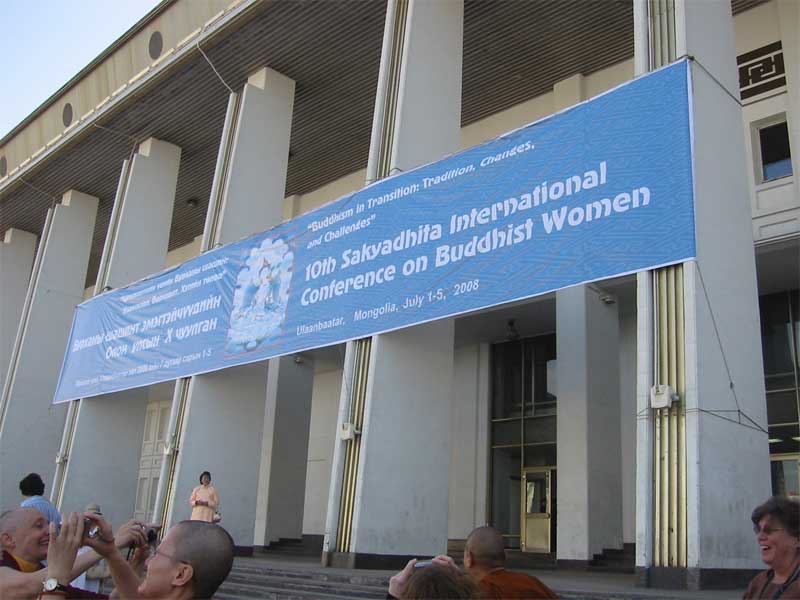
|
| |
|
Mongolia is situated just above China, just below Russia, not an enviable position to be in. It is the world’s largest landlocked nation, with truly awful weather (think Siberia), although there is a short mild summer. Most of the year is bitter cold, with little rainfall, so you don’t have beautiful fluffy snow but solid dirty ice or slush.
The country is about the size of Alaska (1.565 million sq. km.), with a population of a little less than three million. That is less than the population of Los Angeles, and just a little more than Chicago. So you’ve got few people, huge spaces, open air and open sky. The Mongolians for centuries have been nomadic people, living in yurts, (which are called gers), herding horses, sheep, camels, goats. They live on and travel across vast stretches of open land for grazing.
The Sakyadhita Conference, July 1-5
Sakyadhita is the international association of Buddhist women, and this conference was the tenth gathering in twenty years where Buddhist women from everywhere convened to talk about what it is to be a Buddhist woman in the contemporary world.
Thirty countries were represented—from Vietnam to Canada, from Tibet to Germany—among the 400 participants.
To give a sense of the atmosphere at the conference, I have to fill you in on the recent history of Mongolia. It had been a strongly Buddhist country (practicing a form of Tibetan Buddhism) for centuries, until in 1921 the USSR took over Mongolia and instituted Communist rule. By the 1930s they were purging Buddhists. 17,000 high ranking monks were arrested and persecuted. Thousands of monks were killed. 700 temples were forced to close down. Monasteries were destroyed and treasures stolen. Younger monks were conscripted into the army.
For seventy years, Mongolians lived under Communist rule. Then, in 1990, Social Democratic movements took power from the communists. Since then (only 18 years) the country has been in transition from a satellite of Communist Russia to an independent capitalist democratic country.
This transition has many aspects, both positive and negative. (There were violent political demonstrations in Ulaan Baatar while we were there, which you may have read about.) But one major aspect of the transition is the reconstruction and revival of Buddhist practices and institutions.
We were told that 81% of Mongolians profess a faith in Buddhism and Buddhist teachings. There is even a Buddhist radio station in Ulaan Baatar called “Three Jewels.” There is an Association of Mongolian Buddhist Students with 1500 members, the majority women; and some Buddhist women’s groups have formed.
But because any expression of religion or spirituality was forbidden and severely punished for seventy years, the Mongolians have lost their Buddhist history and their practices.
So—each morning 150 to 200 Mongolian women got on buses in Ulaan Baatar and came out to where our conference was held, to ask us about our Buddhist practice. They were passionately hungry for any information we could give them. Through their ad hoc young translators they asked us endless questions:
How did you come to Buddhism? Why did you become a Buddhist? Were your parents Buddhists? How long have you practiced? Has it changed your life? What practices do you do?
A typical discussion group would consist of six or eight of us foreigners, perhaps a woman from Thailand, three nuns from Korea, a laywoman from the U.S., two Vietnamese nuns—and then, filling out the circle, twenty or more Mongolian women. Take a look at the photograph below, and you’ll see how eagerly they leaned forward and wanted to connect with us.
When it was our turn to ask questions of them, they told us about the groups they are establishing, their work in translation and teaching lovingkindness, their work for the rights of women, bringing women together from all of Mongolia, to learn together, teach and care for children.
Sharing in this way was a very moving experience. We had come, in a sense, to talk with each other about Buddhist women’s issues, to give papers on panels and hold discussion groups. But we found that what was asked of us was to give a great deal every day to the Mongolian women. They wanted our information, our insights, our enthusiasm, our experience. Sometimes it was exhausting to have so much demanded of me, yet it felt auspicious and useful to be there at this time.
|
| |
|
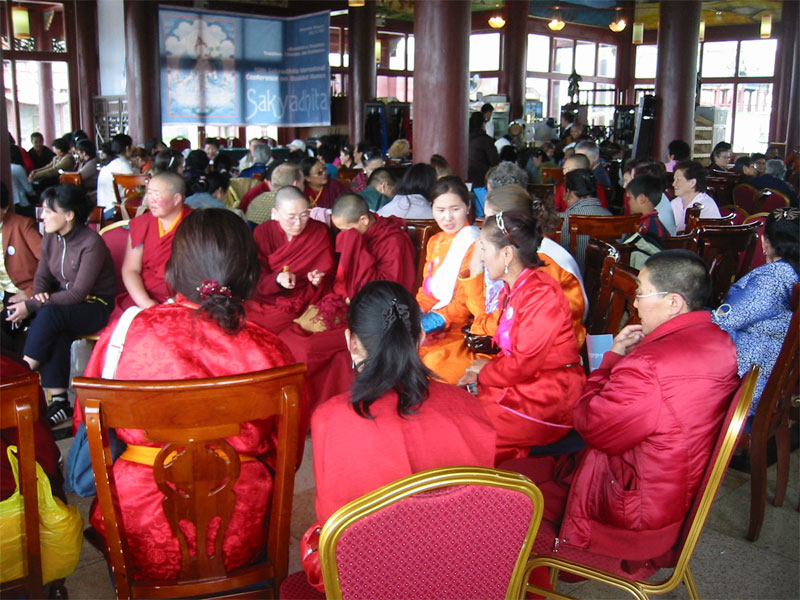
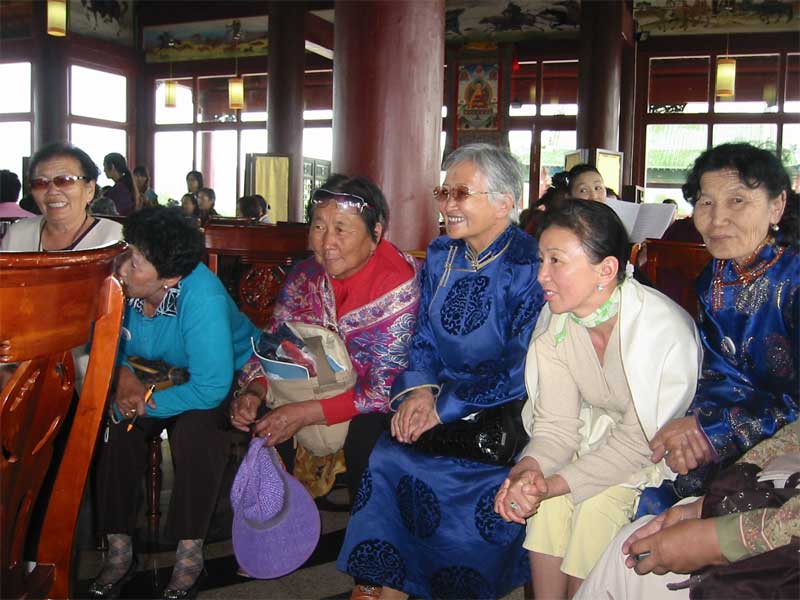
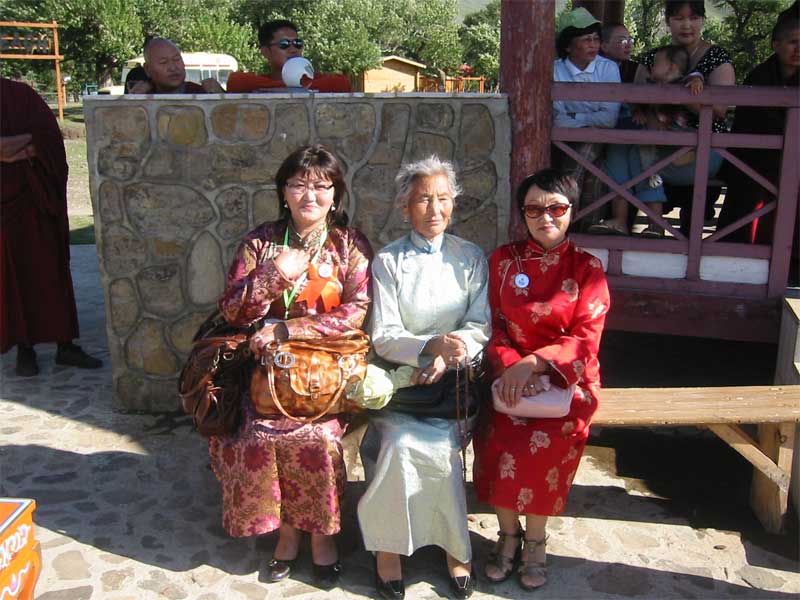
|
| |
|
Being Blessed by an Emanation of Tara
We had been told that in Mongolia there were women who were recognized as reincarnated lamas (very unusual in Tibetan Buddhism) and women recognized as living emanations of Tara. Tara, as you probably know, is the most popular and best-known Tibetan Buddhist goddess. She represents compassion, and the culmination of the spiritual path. She rushes into the world to save people from danger.
One day while we were eating lunch on the balcony of the conference hotel, someone told me that an emanation of Tara had arrived. She had come from Western Mongolia to visit us. So there she was, a plump woman in a yellow beanie. (see photo below) People were coming up to her to be blessed by her, holding out the blue scarves we had received.
My friend Phyllis Pay, who is a devoted Tibetan Buddhist, went up to Tara, bowed before her and held out the blue scarf. Tara took the scarf, put it around Phyllis’s neck, leaned forward to say something to the top of her head. Then I saw Phyllis slip her a few small bills, which she slid into her robe.
“Aren’t you going to get a blessing?” Phyllis asked.
I shook my head no, thinking, I’m not a Tibetan Buddhist, and I’m not sure I subscribe to the possibility of a living emanation of Tara. I started to walk away. Then I thought, But, gee, if this really is Tara, available to bless us, what a fool I would be not to take advantage of the offer!
So I went back, accepted the blue scarf from Phyllis, and went up to Tara. I bowed before her, offered the scarf, which she put over my neck, and then I felt her blowing on the top of my head, speaking words in Mongolian. (Phyllis said later that she was spitting on me.) I gave her some Mongolian money, which she tucked in her robe.
Walking about, after the blessing, in the bright sunshine, beneath that immense vivid sky, my mind felt clear and open. I thought of Maurine Stuart Roshi’s speaking of the “clear light in the mind.” It lasted for quite a while, and I thought, Hmmm, maybe that really is . . .
|
| |
|
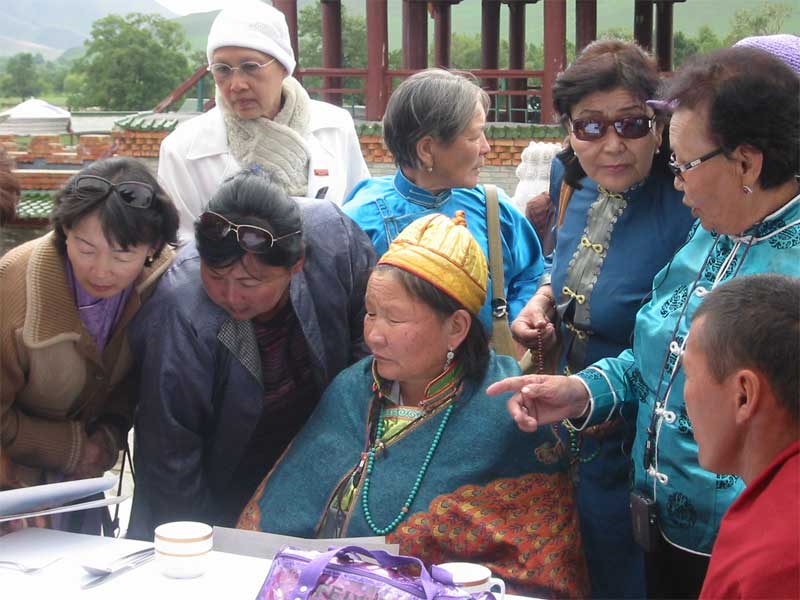
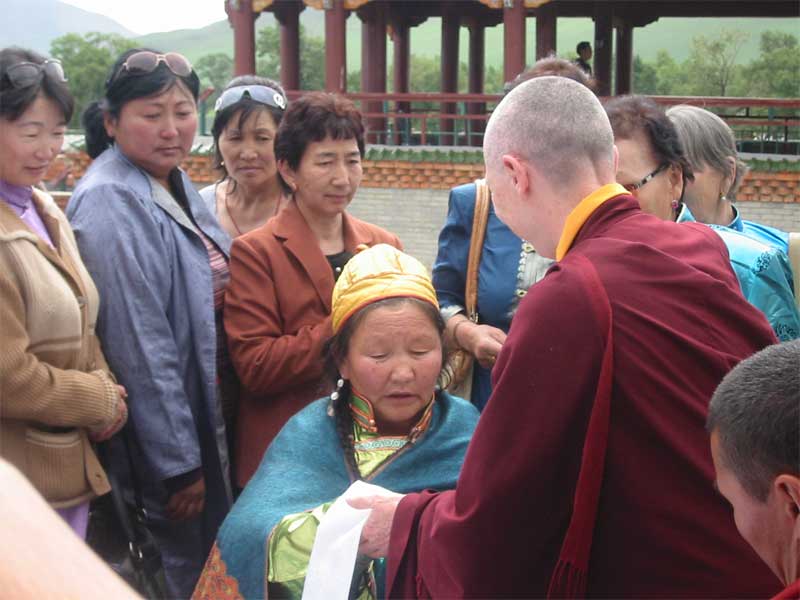
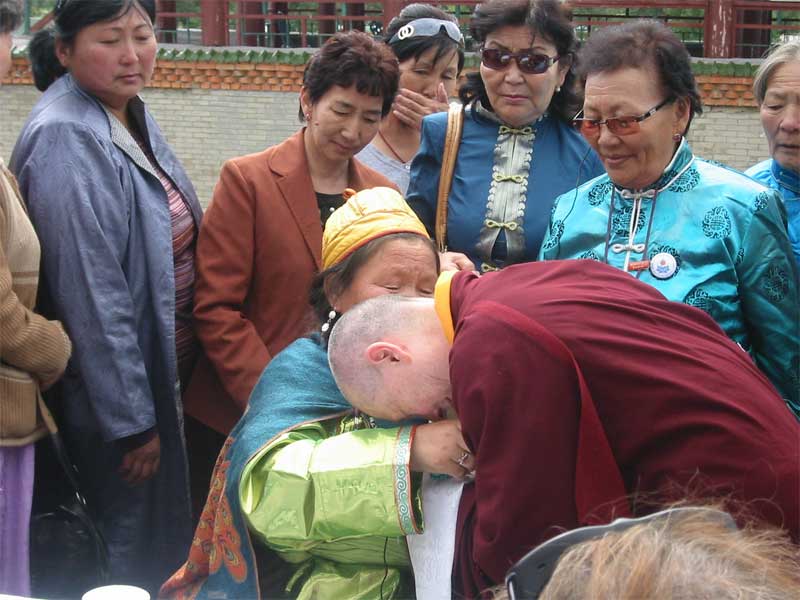
|
| |
|
When lunch was over and we gathered for our afternoon session, Tara agreed to address the group. Standing before the four hundred of us, speaking through one of the young ad hoc translators, she talked very briefly. This is what she said:
I was in my mother’s womb for three years before I was born.
At the age of three I was recognized as a reincarnation of Tara.
I have built seven temples and have planted thousands of trees.
I say to you, Respect your natural environment. Respect and love one another.
A Women’s Temple, A Women’s Tantric Shamanic Practice
On a short tour after the conference, we were taken to the Narkhajid Monastery, a completely female temple, whose reigning deity is Vajrayogini.
Vajrayogini is a Tantric Buddhist meditation deity. She embodies the fully enlightened, female, wild, fiery and energetic (shakti/kundalini) aspect of a Buddha. You could say that she is the Buddhist version of Kali/Durga.
There she was, at the front of the small crowded temple, a painting of a naked dancing female in a seductive pose. She held a blood-filled skull cup in one hand, and in the other a curved knife for cutting up corpses. (In Tibet and perhaps in Mongolia, they practice what is called “sky burial,” in which they take the dead body up a mountainside, cut it in pieces and leave it for the vultures to eat the flesh, thus returning the body to the universe.) A garland of human skulls or severed heads hung around her neck. Her face showed a fierce, ecstatic expression. “Her radiant red body blazed with the heat of yogic fire and was surrounded by the flames of wisdom.”
We were welcomed to the temple by drums and cymbals. The red-robed women (most of them young) took us inside, where they performed a long chanting ceremony, with a drum in one hand, a bell in the other, now and then putting down bell and drum to blow a thigh-trumpet, a horn made from a human thigh bone. A long black fringe covered their faces so that you could not see their eyes or mouths.
To be there in that temple, surrounded by the townspeople, male and female, who had come for the benefit of the chanting, and to hear these women chanting, watch them performing the rites, was thrilling. It felt ancient, shamanic, women’s primeval power expressing itself.
|
| |
|
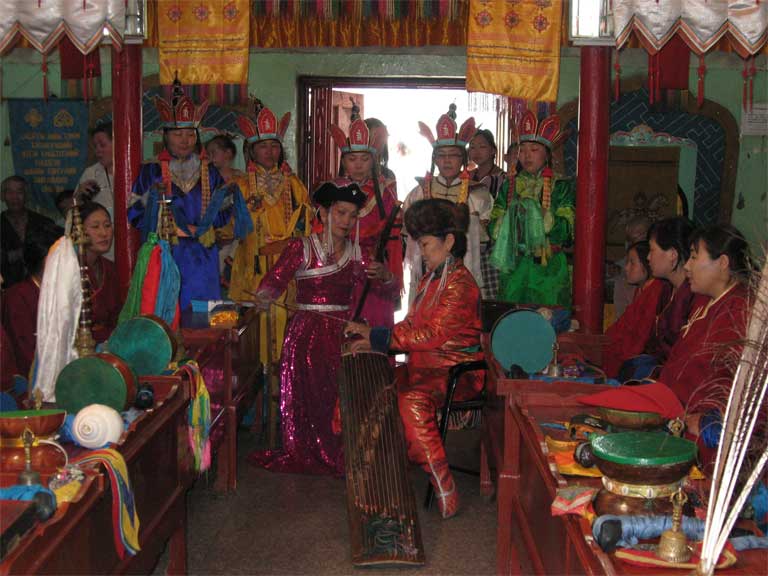
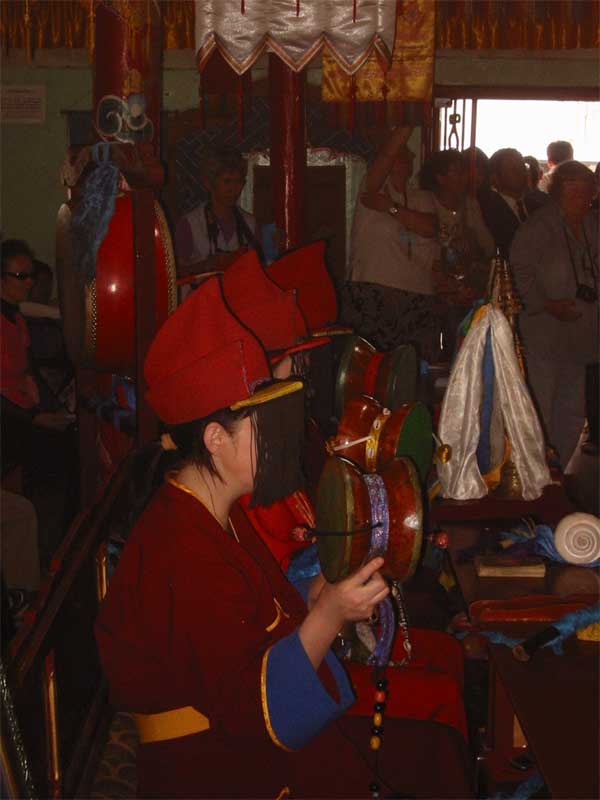
|
| |
|
When they had finished, we asked the one woman who spoke English, “Why do you cover your face when you chant?”
She answered, “When we chant, we are calling in beings from all the other dimensions, to heal them, to create healing for all beings in the universe. But we know that beings from other realms are afraid of us humans, so we have to disguise ourselves in order not to frighten them.”
Many of us felt tremendously honored to have been included in this esoteric practice. We were told that before undertaking this particular chanting ceremony, the women stay up all night for nine nights in preparation, preferably in a cemetery. The practice they were doing, which is a traditional practice in Tibetan Buddhism, is the Chod practice—feeding the demons.
A Last Story
Two years ago I went to the Sakyadhita Conference in Malaysia, a very different experience from Mongolia, being in such a different part of the world and hosted by mainly Malaysian Chinese Buddhists. At that conference there was one Mongolian woman. She was young and very beautiful, with long lustrous black hair down her back and shining black eyes. She was dressed in an ankle-length robe of heavy red felt, totally unsuited to the tropical climate in Malaysia. She spoke none of the languages used at the conference and as there was usually not anyone to translate for her, she remained mute and marginal, a figure at the edge of the proceedings.
I had noticed her, and wondered about her—how she had managed to get there and what kind of experience she was having. And then I forgot her.
On the night after the last day of the conference in Malaysia, I had to get up to pack in the middle of the night to be ready for the bus to the airport at some ungodly early hour. We were sleeping in a large shadowy room, 150 women on mats on the floor. I went to a corner and in the half-dark started packing up my things. Because the Chinese Buddhists in Malaysia had given us so many gifts, I had bought a cheap zippered bag to put my new belongings in. So I stuffed it full of the gifts—shoulder bag, plaque, ornamental tea holder, packets of Malaysian coffee, etc.—and heaving a sigh pulled the zipper closed.
Pop! The zipper gave way, the bag opened like a wide mouth, and out spilled my gifts.
Oh no, what was I to do, here at 4 a.m. in a roomful of sleeping women, with no access to anything to fix the bag? I felt like crying, as I stared at the mess the bag had become there on the floor in front of me.
Then, out from the shadows at the other end of the room, came the young Mongolian woman in her red robe. Without a word, she squatted before me, on the other side of the bag, and the two of us struggled with bits of string, tape, a length of rope she produced, to pull the bag back together and close it sufficiently to withstand the baggage carriers at the airport.
She worked with great concentration, as her fingers and mine cooperated in tying, tightening, pulling. When we had finished, she sat back on her heels and gave me a gentle satisfied smile. I put my hands together to bow in gratitude to her. Then she stood, and melted back into the shadows. The kindness, the patience and generosity she had shown gave me the feeling that we had shared an intimate experience.
So, when I heard that Sakyadhita would be held in Mongolia this year, I wondered, Will I see my Mongolian woman?
It felt just right, then, when we pulled up in our bus before the Narkhajid Temple, where young women in red robes played drums and cymbals and horns to welcome us, to see that one of the drummers was my benefactor. (She’s the one on the right in the photo below.)
At first she did not remember me, then later she did, and gave me a gift of a dvd of their ceremonies (a precious recording), and a key ring of a miniature Mongolian woman’s felt boot as well as a little toy ger (yurt). She also gave me a card, in Mongolian, from the temple, and when we drove away in our bus, she was standing outside to wave at us.
Now I wonder whether I will ever see that face again. Somehow I believe I will, if only in dreams of deep shamanic practice beneath an immense azure sky.
|
| |
|
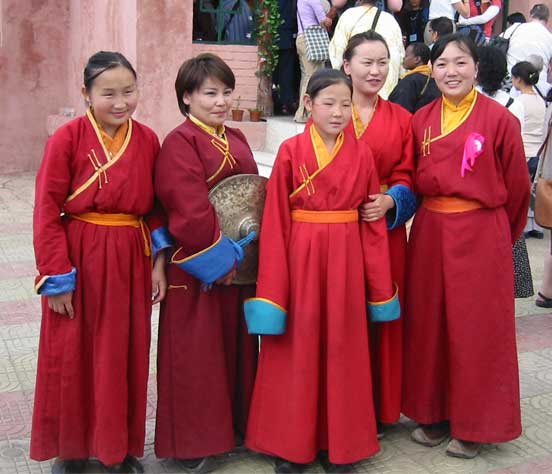
|
| |
|
Final Thoughts
In our context of rapid globalization, in which every part of the world is beginning to be connected with, dependent upon, enriched by, every other part, I’m happy to have been able to get to know, even so briefly, a part of the world that I had rarely thought about. Mongolia is real to me now—the people, the spiritual practice, the politics, the land and the Eternal Blue Sky. I hope with my observations above I’ve made it a little more real for you too.
Sandy
|










